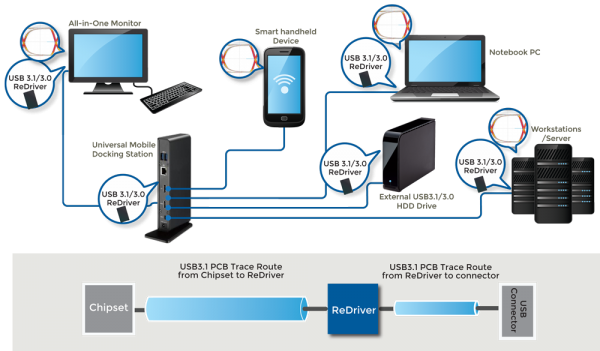Redriver,也称为讯号中继器(Repeater IC),可以重新产生讯号,在高速接口上增加讯号质量。高速的讯号频率造成设计上可用的宽裕度降低,增加设计耐用、高性能系统的难度。透过使用同等化(equalization)、预强调(pre-emphasis)和其他技术,可让单一ReDriver调整与矫正传输端上频道的损失,并在接收端上恢复讯号完整性。因此可以在接生端产生宽裕度足以满足传送可靠讯号、减少讯号错误率的眼图 。

Redriver讯号中继器(Repeater IC)是解决设计复杂设计难题的关键的技术,现今各种应用的高速链接所需的高速数据传输通讯协议都可以应用。为了让更佳完善讯息能够在电路上传送,采用极佳的讯号调适技术,提供redrivers。Redrivers提供比基于协议讯号更好的性能,不需要在终端点终止信号,然后重新传送,因此消除延迟和附加系统成本。此外,redrivers调节与传递讯号是透过物理层工作,因此有极少的讯号抖动 。
Diodes ReDrivers address the five major issues negatively impacting the signal integrity of high-speed interfaces:
Signal Attenuation: High-speed signals, including differential signals, introduce noise and jitter that causes signal voltage swings to overshoot or undershoot the optimal eye opening. This results in a degraded signal during high-speed signal switching.
Signal Strength: Interfaces are increasingly being integrated into CPU chipsets. While providing excellent performance in the lab, many of these chipsets are often not strong enough to provide reasonable design margin to meet compliance specs when designed into real-world systems with multi-layer boards, long traces, and extended cable lengths.
Signal Distance: Layout constraints, controller-to-connector separation, multiple PCB layers, vias, daughterboard connectors, and extensive cable lengths all contribute to signal distance and greater signal degradation. For example, signal losses over FR4 PCB traces are typically 0.3dB per inch at 2.5 Gbps and 0.9 dB at 8 Gbps.
Noise: Both random and deterministic noise degrade signal integrity from a variety of sources, including crosstalk from other signals. Another common source of random jitter is a noisy clock source that does not have good isolation or has impedance mismatches.
Lack of end-to-end control: When an interface connects to an external subsystem or device, designers do have not control over the signal distance, board vias, connectors, and cables over which the signal must still pass to reach its destination. This can increase noise, jitter, attenuation, and insertion losses, and cause otherwise well-designed devices to fail to interface to equipment from other manufacturers.
The challenge for OEMs is that, as signal speeds increase, these factors become more pronounced, causing reliability, throughput, and quality to suffer. To help developers maintain signal integrity, Diodes offers unparalleled signal conditioning technology with a comprehensive portfolio of devices for PCI Express, USB, Thunderbolt, SAS/SATA, Bluetooth, Wi-Fi, HDMI, and other popular standards. Benefits include:
Superior Signal Quality: Diodes ReDrivers have the lowest jitter and attenuation for the highest performance in the industry. Comparative studies are available under NDA.
Lowest Crosstalk: By minimizing crosstalk, Diodes keeps channel-to-channel and part-to-part skew low.
Highly configurable: To provide developers greater flexibility, Diodes' ReDrivers can be configured on a per channel basis via an MCU over I2C rather than having to be pinstrapped or hardwired like other technologies.
Power Efficiency: These devices are architected for both low power operation and efficient power consumption. For example, Diodes' SAS/SATA redrivers consume less than 100 mW per channel and have the best power efficiency on the market.
Multi-port: Diodes' redrivers support a variety of multi-channels configurations, providing flexibility while enabling greater integration and cost savings.
Multi-protocol: Diodes' is the only manufacturer in the industry to offer a comprehensive portfolio of redrivers that work in both SATA and SAS environments.
Flexible packaging: Diodes' redrivers come in a variety of packaging options to meet the specific cost, performance, and power needs of your application. With devices on the order of 4 mm x 4 mm, these redrivers can be placed close the interface connector to minimize signal losses.
Improving signal integrity increases the overall signal margin of systems. OEMs can use this increased signal margin to:
Diodes' is the market leader in redriver technology across applications, including networking, embedded computing, and communications, among others. For example, in the server market, Diodes' was the first redriver manufacturer to achieve SATA3 compliance, and its technology has been adopted in more than 80% of server storage designs. Diodes' redrivers are also part of many controller vendor reference designs, including Intel.
As part of its commitment as the signal integrity leader, Diodes' offers unparalleled design support to its customers, including availability of evaluation boards, professional schematic and layout review, and system simulation to optimize the key opening using S-Parameter models, AMI-IBIS, or HSPICE.
High speed SAS 2.0, SATA 3.0, PCIe 2.0,PCIe 3.0, USB 3.0, DP 1.1 and DP 1.2